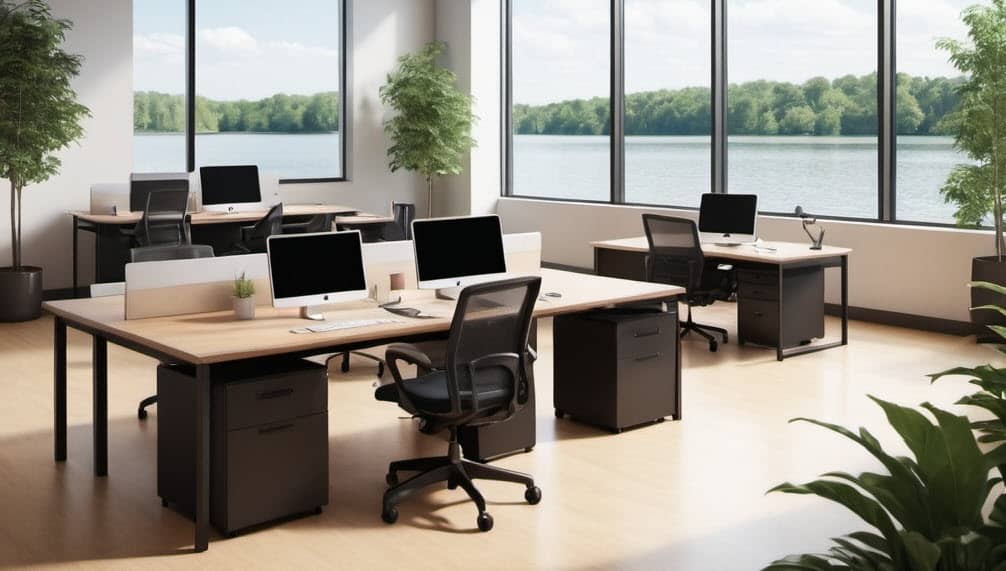
Leasing new office space is a significant milestone for any growing business.
It represents a commitment to expansion, provides legitimacy, and creates a dedicated environment for your team to thrive.
However, navigating the leasing process can be complex and overwhelming for first-time tenants.
This guide will walk you through each step of the journey, from assessing your needs to maximizing your new space for business growth.
Table of Contents
Assessing Your Office Space Needs
Before diving into the leasing process, it’s crucial to determine whether you actually need a physical office space. Consider the following factors:
- Team size and growth projections: Analyze your current team size and forecast growth over the next 3-5 years. Consider how many employees will be in the office full-time, part-time, or remotely. Factor in potential department expansions or new hires.
- Nature of your work: Evaluate whether your business is primarily client-facing or can operate remotely. Client-facing businesses may require a more professional setting, while remote-friendly companies might need less space or could consider flexible options.
- Budget constraints: Determine how much you can realistically afford for rent and associated costs. Consider your current revenue, projected growth, and other financial obligations. Remember that office space should typically not exceed 10-15% of your gross revenue.
- Company culture and collaboration needs: Assess your company’s work style. Do you need open spaces for collaboration, private offices for focused work, or a mix of both? Consider how your office space can reflect and enhance your company culture.
If you decide that an office is necessary, calculate your space requirements carefully. A general rule of thumb is to allocate 150-175 square feet per employee for a traditional office layout. However, this can vary widely depending on your specific needs and desired office style.
Example: A tech startup with 20 employees might need approximately 3,000-3,500 square feet for a traditional layout. However, if they opt for an open-plan design, they might be able to reduce this to 2,000-2,500 square feet.
Consider different types of office spaces:
- Private offices: Offer the most control and customization. Ideal for businesses that require confidentiality or have many client meetings. You can design the space to perfectly fit your needs but may have higher costs and longer lease terms.
- Coworking spaces: Provide flexibility and networking opportunities. Great for startups or small businesses that want a professional environment without having to commit to a long-term lease. Often come with amenities like meeting rooms and reception services.
- Virtual offices: Offer a professional address without physical space. Suitable for businesses that operate remotely but need a business address for mail and occasional meeting space. Can be a cost-effective solution for startups or solopreneurs.
When evaluating your needs, think about the various zones your office will require:
- Workstations: 60-110 sq ft per employee in open layouts. Consider desk size, storage needs, and equipment requirements.
- Private offices: 90-400 sq ft depending on size and occupant’s role. Factor in space for a desk, chairs, and small meeting area if necessary.
- Conference rooms: 50 – 75 sq ft + 25 sq ft per person. Plan for different sizes to accommodate various meeting types.
- Collaborative areas: 80-100 sq ft per person. Include informal meeting spaces, brainstorming areas, and lounges.
- Reception area: 100-200 sq ft. Consider the first impression this space will make on clients and visitors.
- Break room or kitchen: 75 sq ft + 25 sq ft per person. Include space for appliances, seating, and food preparation.
- Storage and file rooms: 200+ sq ft. Account for document storage, supplies, and any industry-specific storage needs.
Remember to factor in circulation space, which can account for up to 30% of your total square footage. This includes hallways, stairwells, and other areas necessary for movement within the office.
Budgeting for Your Office Lease
Developing a comprehensive budget is critical for a successful office lease. Consider the following expenses:
- Base rent: The primary cost, typically quoted per square foot annually. Rates vary widely based on location, building quality, and market conditions.
- Security deposit: Usually 1-3 months’ rent, held by the landlord as protection against damages or unpaid rent.
- Utilities: Can include electricity, water, gas, and internet. Some leases include these costs, while others require separate payment.
- Maintenance and repairs: Depending on your lease type, you may be responsible for some or all maintenance costs.
- Insurance: Typically includes general liability and property insurance. Costs vary based on coverage and business type.
- Property taxes: In some lease types, tenants are responsible for a portion of the building’s property taxes.
- Parking fees: If not included in the lease, factor in costs for employee and visitor parking.
- Technology and infrastructure setup: Include costs for setting up internet, phone systems, and any specialized technology needs.
Understand different lease types:
- Full-service lease: Landlord covers most operating expenses, including utilities, maintenance, and sometimes janitorial services. The rent is typically higher, but costs are more predictable.
- Triple-net (NNN) lease: Tenant is responsible for property taxes, insurance, and maintenance in addition to base rent. While the base rent is lower, total costs can be higher and less predictable.
Read our Ultimate Commercial Lease Guide for more information about the different types of leases.
Example: For a 3,000 sq ft office in a mid-tier city, you might expect:
- Base rent: $15-$25 per sq ft annually ($3,750-$6,250 per month)
- Security deposit: $11,250-$18,750 (3 months’ rent)
- Utilities: $1-$2 per sq ft annually ($250-$500 per month)
- Insurance: $500-$1,000 annually
Factor in hidden costs and upfront expenses, such as:
- Moving costs: $1,500-$5,000 for a small office. Include packing materials, professional movers, and potential downtime during the move.
- Furniture and equipment: $200-$1,000 per employee. Consider desks, chairs, filing cabinets, and any specialized equipment needed.
- Tenant improvements: $10-$50 per sq ft. This can include painting, flooring, lighting upgrades, or more extensive renovations.
- Legal fees for lease review: $1,500-$3,000. A commercial real estate attorney can help you understand and negotiate lease terms.
Navigating the Office Search Process
Deciding whether to hire a tenant representative broker can significantly impact your search process. A broker can:
- Provide market insights and negotiation expertise: Brokers have access to comprehensive market data and can leverage their experience to negotiate better terms.
- Save you time by pre-screening properties: They can filter options based on your specific needs, saving you from visiting unsuitable properties.
- Potentially secure better lease terms: Their knowledge of market conditions and landlord motivations can lead to more favorable lease terms.
Online Search Tools
When searching for a new office space, online search tools can be invaluable resources to streamline your search process and explore a wide range of options.
- LoopNet: Popular marketplace with extensive database of office spaces for lease or sale, offering detailed property information and high-quality images
- CoStar: Parent company of LoopNet, provides comprehensive data and analytics for commercial real estate, ideal for in-depth market research
- CommercialSearch: Free, user-friendly platform with a nationwide database of over 330,000 commercial property listings, updated daily
- OfficeSpace.com: Allows free browsing of commercial listings in your area, featuring a variety of office, retail, and industrial spaces
- WeWork and Regus: Offer listings for coworking spaces and private offices with short-term lease options, suitable for flexible workspace solutions
- OfficeFinder: Connects users with local commercial real estate professionals for personalized assistance in office space searches
When researching potential locations, consider:
- Proximity to clients, employees, and amenities: Look for locations that are convenient for your team and clients. Consider nearby restaurants, shops, and services that can benefit your employees.
- Public transportation and parking options: Ensure easy access for employees and visitors. Consider proximity to public transit and availability of parking.
- Neighborhood safety and reputation: Research crime rates and the overall reputation of the area. A safe, reputable location can positively impact your business image.
Example: A marketing agency might prioritize a trendy downtown location to attract creative talent and impress clients, while a manufacturing company might prefer an industrial park with easy highway access for deliveries.
Evaluate building amenities and services, such as:
- Security systems: Look for buildings with 24/7 security, access control systems, and surveillance cameras.
- Maintenance and cleaning services: Understand what’s included in your lease and what additional services are available.
- Conference rooms and common areas: Some buildings offer shared spaces that can supplement your leased area.
- On-site parking or gym facilities: These amenities can be attractive perks for employees and visitors.
Negotiating Your Office Lease
Key lease terms to consider include:
- Lease length and renewal options: Typical commercial leases range from 3-10 years. Negotiate renewal options to secure your space long-term while maintaining flexibility.
- Rent escalation clauses: Expect annual increases of 2-3%. Try to negotiate caps on these increases or tie them to specific indices.
- Subletting rights: Ensure you have the ability to sublet if your space needs change.
- Early termination options: Negotiate the ability to end the lease early, possibly with a penalty, to maintain flexibility.
- Tenant improvement allowances: Negotiate for the landlord to cover some or all of the costs to customize the space.
Strategies for securing favorable lease conditions:
- Research market rates and comparable properties: Arm yourself with knowledge about local market conditions to negotiate effectively.
- Be prepared to walk away from negotiations: Look for alternative options that give you leverage in negotiations.
- Negotiate for free rent periods or reduced rates during build-out: This can help offset initial moving and setup costs.
- Seek flexibility for future expansion or downsizing: Negotiate rights of first refusal on adjacent spaces or options to reduce space if needed.
Example: If you’re signing a 5-year lease, you might negotiate for:
- 2-3 months of free rent at the beginning of the term
- A tenant improvement allowance of $30-$50 per sq ft
- The right to sublease up to 25% of the space
- An option to renew for an additional 3-5 years at pre-negotiated terms
Designing and Building Out Your Space
Customizing your office to reflect company culture can boost morale and increase productivity. Consider:
- Open vs. closed floor plans: Decide on the balance between collaborative open spaces and private areas for focused work.
- Collaborative spaces and quiet zones: Design areas for team meetings, brainstorming sessions, client meetings, as well as quiet spaces for concentration.
- Branding elements and color schemes: Incorporate your company’s logo, colors, and values into the office design to reinforce brand identity.
Managing the build-out process:
- Hire a reputable architect or space planner: They can help optimize your layout and ensure compliance with building codes and regulations.
- Obtain permits and approvals: Work with local authorities to secure all required permits for renovations.
- Coordinate with building management for construction schedules: Ensure your build-out doesn’t disrupt other tenants and complies with building rules.
Balance current needs with future scalability by designing flexible spaces that can adapt to growth. For example, use modular furniture systems that can be easily reconfigured as your team expands.
Preparing for the Move
Create a comprehensive moving plan that includes:
- Timeline for packing and unpacking: Start planning 2-3 months in advance. Create a detailed schedule for packing, moving, and unpacking.
- Inventory of furniture and equipment: Document all items being moved to ensure nothing is lost or damaged during the transition.
- Coordination with IT for technology setup: Plan for the transfer and setup of all technology systems, including computers, servers, and phone systems.
Notify stakeholders and update business information:
- Inform clients, vendors, and partners of your new address: Send out notifications well in advance of the move.
- Update your marketing materials: Ensure all online and offline materials reflect your new location.
- File change of address forms with relevant authorities: Update your address with the post office, tax authorities, and other relevant agencies.
Set up essential services in the new space, such as:
- Internet and phone systems: Arrange for installation well before your move-in date to ensure connectivity from day one.
- Utilities: Set up accounts for electricity, water, and gas if not included in your lease.
- Security systems: Install any additional security measures specific to your business needs.
Example Moving Timeline:
- 8 weeks before: Hire movers and begin planning
- 6 weeks before: Start purging unnecessary items
- 4 weeks before: Begin packing non-essential items
- 2 weeks before: Finalize IT setup plans
- 1 week before: Pack remaining items and prepare workstations
- Moving day: Oversee the move and begin unpacking essentials
- 1 week after: Finish unpacking and settling in
Maximizing Your New Office Space
Establish office policies and culture:
- Create guidelines for space usage and shared areas: Develop clear policies for meeting room bookings, kitchen use, and other shared spaces.
- Implement sustainability practices: Introduce recycling programs, energy-efficient practices, and other eco-friendly initiatives.
- Foster a welcoming environment for employees and visitors: Create a warm and inviting atmosphere that reflects your company culture.
Implement security measures:
- Install access control systems: Use key cards or biometric systems to control and monitor access to your office.
- Set up secure document storage: Implement both physical and digital systems for securing sensitive information.
- Train employees on security protocols: Educate your team on best practices for maintaining office security.
Foster a productive work environment by:
- Optimizing lighting and temperature control: Ensure proper lighting and comfortable temperatures throughout the office.
- Providing ergonomic furniture and equipment: Invest in adjustable chairs, standing desks, and proper computer setups to promote employee health and comfort, as well as increase productivity.
- Creating spaces for both collaboration and focused work: Design a mix of open collaborative areas and quiet spaces for concentrated work.
Example: Implement a hot-desking system for hybrid workers, while maintaining dedicated spaces for full-time in-office employees. Create “phone booths” for private calls and small meeting rooms for impromptu collaborations.
Legal Considerations and Compliance
Review lease agreements and legal obligations carefully:
- Consider hiring a real estate attorney for lease review: They can help you understand complex lease terms and negotiate favorable conditions.
- Understand your rights and responsibilities as a tenant: Be clear on what you’re responsible for in terms of maintenance, repairs, and other obligations.
Ensure compliance with:
- Zoning laws and business licenses: Verify that your intended use of the space is allowed under local zoning regulations.
- Building codes and safety regulations: Ensure your office meets all relevant building and safety codes, including fire safety requirements.
- ADA accessibility requirements: Make necessary modifications to ensure your office is accessible to individuals with disabilities.
Obtain proper insurance coverage:
- General liability insurance: Protects against claims for bodily injury or property damage.
- Property insurance for your belongings: Covers your furniture, equipment, and other business property.
- Workers’ compensation insurance: Required in most states to cover employee injuries or illnesses related to work.
Leveraging Your Office Space for Business Growth
Use your office for branding and marketing purposes:
- Design an impressive reception area: Create a welcoming first impression that reflects your brand identity.
- Create Instagram-worthy spaces for social media content: Design visually appealing areas that can be featured in your social media marketing.
- Display your company’s achievements and values: Use wall space to showcase awards, mission statements, and company milestones.
Host events and client meetings:
- Utilize conference rooms for presentations: Equip meeting spaces with modern presentation technology.
- Organize open houses or networking events: Use your office to host industry events or client appreciation gatherings.
- Offer tours to potential clients or partners: Showcase your office as
Are you looking for office space for lease in Macomb County? Please contact us or call us at (586) 262-6270 , and we’ll be happy to help you find the perfect space for your needs.



Leave a Reply